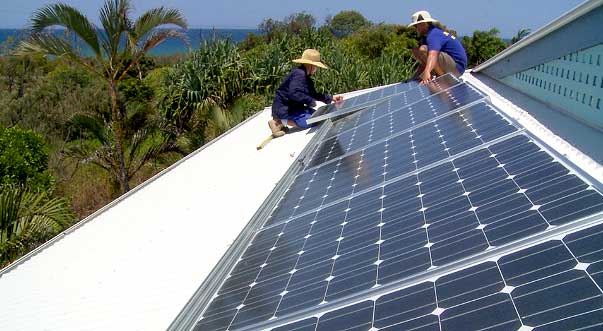Solar Panel Energy Calculators
We recently installed a 1 KW solar panel array above our office here at Ecofilms. I must admit we didn’t give it too much thought until the installers arrived with the solar panels.
Feeding back to the grid is one thing but having a inverter box bolted to the wall of the office with it’s red blinking lights constantly flashing makes you take a closer look and watch how much actual Kilowatt energy is really being captured by these six panels?

This got us thinking about about our location and if there is some sort of chart or calculator available on the internet than can tell you how much sunshine is available to you on any given month of the year and what kind of performance you can gain for your system or how many Kw can be captured in your geographic area.
Somewhere there must be a chart available to look at and compare the data. Well there is but you do need to know a couple of things about your system and place where you live.
There are a few calculators available online. Some overly complicated with all sorts of parameters you can fiddle with. Not being much of a geek a lot of the info left me more bewildered than illuminated. However, you do need to know a couple of details. Your Latitude and Longitude. Typing those two words into Google plus your location quickly gives you the coordinates, but be careful and double check as the information as not all information you get on the internet is accurate.

Sun Chart Calculator gives you a pretty nice looking sun chart based on your location.
The chart can be displayed as either pdf or png graphic and can be useful in understanding the elevation angle and azimuth angle of the sun over your house.
The chart has many options and can chart the sun’s performance over the entire year.
The sun path is charted or plotted in Cartesian coordinates and the parameters can be tweaked based on whether you live in either the northern or southern hemispheres.
The Renewable Resource Data Center (RReDC) provides access to an extensive collection of renewable energy resource data, maps, and tools. An interesting calculator to try is the PVWatts performance calculator. There are two versions to try. One based for US residents and a rest of the world version. Here you should consult you solar panel handbook for energy ratings if you know them as many parameters can be set such as the size and power of your photovoltaic panels etc. We used the default settings to verify the fact that – yes if you live in Queensland Australia – you do get a lot of sunshine over the year. More than most other cities around Australia.







The PVWatts performance calculator is quite easy to use. Queensland does get a lot of sunshine, making it ideal for those who want to solar power. Other cities may not has that much sunshine but there are things that can be done to augment it. Thanks.